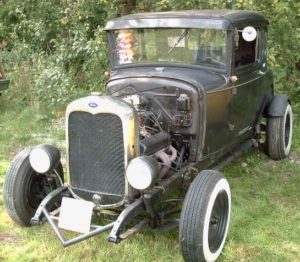Automotive Batteries
by: Barbara Moore

1930 Model A Ford image By Morepowerigor (Own work) [GFDL (http://www.gnu.org/copyleft/fdl.html) or CC BY-SA 4.0-3.0-2.5-2.0-1.0 (http://creativecommons.org/licenses/by-sa/4.0-3.0-2.5-2.0-1.0)], via Wikimedia Commons
Think of the battery as the heart of your car. You need a battery you can count on to get your motor running and keep it pumping all day long.
The car battery is an essential element of the intricate network that makes your car start and keeps the engine running. The battery powers most of the car’s electrical components and accessory structures, such as the headlights, turn signals, fans, etc. While the alternator provides most of the electrical needs of the entire car system, the battery can keep them going in the event of an alternator malfunction.
There are many batteries available at automotive supply stores, and it’s important to know exactly which model is the right choice for your car. The wrong battery won’t work in your car, and it may even cause damage to the vehicle. Knowing which battery is right for your particular vehicle is extremely important, and it can also help to learn about the various battery manufacturers and automotive supply companies. You should only have to buy a battery every few years, so make sure you’re buying the right one.
* Size Matters: Buying a battery for your car is like choosing a pair of shoes for you. One size does not fit all. The size of the battery itself is important, as it needs to fit snugly into the space allotted under the engine’s hood. If the battery is too small there is the risk of it becoming dismantled and causing vibrations or damage. Further, the battery will either be a top post or side post model, which will determine how it fits and operates.
* Power Up: You need to know your car’s specific power requirements before purchasing a car battery. Some cars need an 8-volt battery, while others require a 12-volt. There are a number of considerations to take into account, such as the size of the car and the number of accessories that must be powered. A huge sound system, for example, can easily suck the life out of an average car battery. A 12-volt battery should be able to maintain at least 7.2 volts when the vehicle is starting and while it is operational.
* Chill Out: If you live in a cold-climate area, it’s important to check the Cold Cranking Amps (CCA) before you buy. CCA is a measurement used to determine a battery’s ability to start an engine at 0° Fahrenheit, within a 30 second period. A higher CCA rating means the battery will start your vehicle faster and more effectively in freezing weather.
* Get it in Writing: No matter how well known the manufacturer is, you need to get a written manufacturers warranty with your battery. Make sure that the battery is in original condition, and is not a recharged model. The quality and dependability of the battery you choose should be indicative of the warranty you’re offered. Make sure that battery is guaranteed for the duration of the battery’s life (ie: if you plan on using the battery for five years, look for a five-year warranty).
* Keep it Fresh: Whether you’re buying bananas or batteries, you need to make sure they’re fresh and damage-free. Just because it’s a piece of car equipment, it’s not OK for your battery to waste away on a stockroom shelf. Make sure that the battery you buy is produced by a known and respected manufacturer, and that it’s fully charged and ready to start your car. If you’re not careful, you can run the risk of purchasing a fake or recharged battery. Look on the side of a battery casing for a special label or decal. You’ll find the month and year that the battery was shipped from the manufacturer’s plant. The letters ‘A’ through ‘M’ represent months of the year. For example, ‘A’ is January and ‘M’ is December. The letter ‘I’ is not used. The numbers 1 through 9 denotes the year of manufacture. Therefore, if the sticker on your batter reads L4, you know that it was manufactured in November 2004.
A car battery provides starting power to your vehicle, so make sure it’s dependable. Understand your car’s requirements and know how to verify the quality of the battery before you make the final purchase.
| About The Author
Barbara Moore writes for several web sites, including http://bokik.com andhttp://curag.com.
|
Article source: Article City
